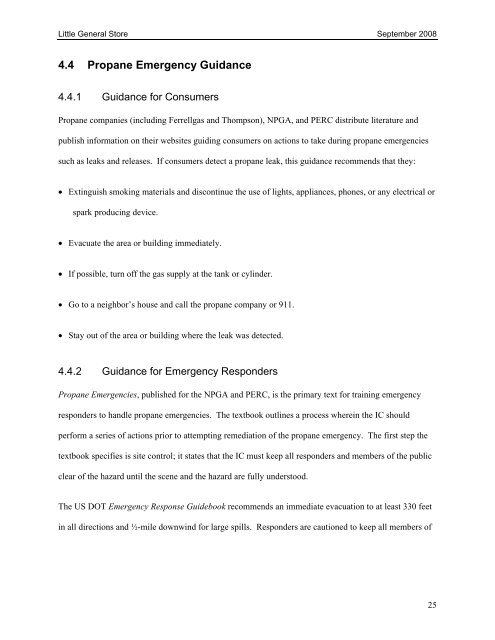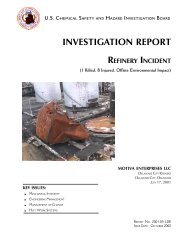Little General Store Propane Explosion - US Chemical Safety and ...
Little General Store Propane Explosion - US Chemical Safety and ...
Little General Store Propane Explosion - US Chemical Safety and ...
You also want an ePaper? Increase the reach of your titles
YUMPU automatically turns print PDFs into web optimized ePapers that Google loves.
<strong>Little</strong> <strong>General</strong> <strong>Store</strong> September 2008<br />
4.4 <strong>Propane</strong> Emergency Guidance<br />
4.4.1 Guidance for Consumers<br />
<strong>Propane</strong> companies (including Ferrellgas <strong>and</strong> Thompson), NPGA, <strong>and</strong> PERC distribute literature <strong>and</strong><br />
publish information on their websites guiding consumers on actions to take during propane emergencies<br />
such as leaks <strong>and</strong> releases. If consumers detect a propane leak, this guidance recommends that they:<br />
• Extinguish smoking materials <strong>and</strong> discontinue the use of lights, appliances, phones, or any electrical or<br />
spark producing device.<br />
• Evacuate the area or building immediately.<br />
• If possible, turn off the gas supply at the tank or cylinder.<br />
• Go to a neighbor’s house <strong>and</strong> call the propane company or 911.<br />
• Stay out of the area or building where the leak was detected.<br />
4.4.2 Guidance for Emergency Responders<br />
<strong>Propane</strong> Emergencies, published for the NPGA <strong>and</strong> PERC, is the primary text for training emergency<br />
responders to h<strong>and</strong>le propane emergencies. The textbook outlines a process wherein the IC should<br />
perform a series of actions prior to attempting remediation of the propane emergency. The first step the<br />
textbook specifies is site control; it states that the IC must keep all responders <strong>and</strong> members of the public<br />
clear of the hazard until the scene <strong>and</strong> the hazard are fully understood.<br />
The <strong>US</strong> DOT Emergency Response Guidebook recommends an immediate evacuation to at least 330 feet<br />
in all directions <strong>and</strong> ½-mile downwind for large spills. Responders are cautioned to keep all members of<br />
25









